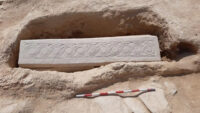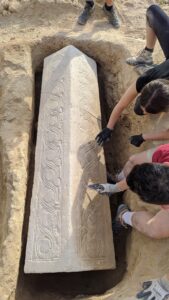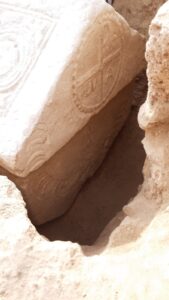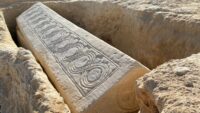 A splendidly carved Visigothic-era sarcophagus has been unearthed from a Roman villa turned necropolis in the township of Mula in Murcia, southeastern Spain. The coffin is two meters (6.5 feet) long and decorated with incised concentric swirls and stylized ivy leaves on a peaked roof. The end of the coffin (side where the head would have lain) is carved with a simplified Chi Ro (the downstroke of the Ro has a crossbar instead of being embedded in the X of the chi) inset into a circle. The style of decoration suggests the sarcophagus dates to the 6th century. It is the only one of its kind ever found in southeast Spain.
A splendidly carved Visigothic-era sarcophagus has been unearthed from a Roman villa turned necropolis in the township of Mula in Murcia, southeastern Spain. The coffin is two meters (6.5 feet) long and decorated with incised concentric swirls and stylized ivy leaves on a peaked roof. The end of the coffin (side where the head would have lain) is carved with a simplified Chi Ro (the downstroke of the Ro has a crossbar instead of being embedded in the X of the chi) inset into a circle. The style of decoration suggests the sarcophagus dates to the 6th century. It is the only one of its kind ever found in southeast Spain.
 A team from the University of Murcia discovered the sarcophagus on Thursday in the Roman villa of Los Villaricos. Los Villaricos was an agricultural and residential complex built on the left bank of the River Mula in the second half of the 1st century. In use through the first half of the 5th century, it is the largest and best-preserved of the Roman estates discovered in Murcia. What was produced at the villa is still unknown. Murcia was rich in natural resources — minerals, wheat, olive oil, marble, sandstone, coastal fisheries for large-scale garum production — the villa was extensively modified and expanded in the 3rd century, and was likely put to different uses at different phases of occupation.
A team from the University of Murcia discovered the sarcophagus on Thursday in the Roman villa of Los Villaricos. Los Villaricos was an agricultural and residential complex built on the left bank of the River Mula in the second half of the 1st century. In use through the first half of the 5th century, it is the largest and best-preserved of the Roman estates discovered in Murcia. What was produced at the villa is still unknown. Murcia was rich in natural resources — minerals, wheat, olive oil, marble, sandstone, coastal fisheries for large-scale garum production — the villa was extensively modified and expanded in the 3rd century, and was likely put to different uses at different phases of occupation.
The villa ceased all industrial activity and was abandoned in the late 5th century. A few scattered residents remained in and around the abandoned villa and a semi-circular apse was added to the large triclinium to convert it into a site of Christian worship. The main hall and atrium of the villa were then reused as prime burial space next to the walls of the church. The mosaic floors, installed during the third phase of refurbishments at the villa (4th century to the first half of the 5th), were torn up to make way for burials which over time expanded to the other rooms of the former residence.
 More than 50 burials dating from the 5th to the 7th century have been found in the necropolis and most of the graves are modest inhumations, sometimes lined with stones along the sides and topped with a single sandstone slab. Recycled tiles and pottery fragments were occasionally added as decorative elements. This sarcophagus is the most luxurious ever found in the necropolis.
More than 50 burials dating from the 5th to the 7th century have been found in the necropolis and most of the graves are modest inhumations, sometimes lined with stones along the sides and topped with a single sandstone slab. Recycled tiles and pottery fragments were occasionally added as decorative elements. This sarcophagus is the most luxurious ever found in the necropolis.
This year’s excavation campaign began last Monday with the goal of completing the excavation of the final three burials in the necropolis and doing an initial exploration of the area just north of the necropolis where some pools were found that are believed to have been used for storage of a still unknown product grown/manufactured at the villa. The discovery of the sarcophagus in the necropolis came as a complete surprise to the team.
 Researchers removed the lid on Friday and found it contained human remains and other elements of as-yet undetermined nature. The contents have been removed for study. The sarcophagus will also be studied and conserved. Eventually it will be put on display in the Ciudad de Mula museum.
Researchers removed the lid on Friday and found it contained human remains and other elements of as-yet undetermined nature. The contents have been removed for study. The sarcophagus will also be studied and conserved. Eventually it will be put on display in the Ciudad de Mula museum.